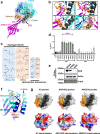RAS-inhibiting biologics identify and probe druggable pockets including an SII-α3 allosteric site
- PMID: 34193876
- PMCID: PMC8245420
- DOI: 10.1038/s41467-021-24316-0
RAS-inhibiting biologics identify and probe druggable pockets including an SII-α3 allosteric site
Abstract
RAS mutations are the most common oncogenic drivers across human cancers, but there remains a paucity of clinically-validated pharmacological inhibitors of RAS, as druggable pockets have proven difficult to identify. Here, we identify two RAS-binding Affimer proteins, K3 and K6, that inhibit nucleotide exchange and downstream signaling pathways with distinct isoform and mutant profiles. Affimer K6 binds in the SI/SII pocket, whilst Affimer K3 is a non-covalent inhibitor of the SII region that reveals a conformer of wild-type RAS with a large, druggable SII/α3 pocket. Competitive NanoBRET between the RAS-binding Affimers and known RAS binding small-molecules demonstrates the potential to use Affimers as tools to identify pharmacophores. This work highlights the potential of using biologics with small interface surfaces to select unseen, druggable conformations in conjunction with pharmacophore identification for hard-to-drug proteins.
Conflict of interest statement
M.J. works for Avacta Life Sciences who licensed the Affimers from the University of Leeds. M.J., M.J.M., D.C.T., and A.L.T. all own personal shares in Avacta Life Sciences. The remaining authors declare no competing interests.
Figures







Similar articles
-
Natural Products Attenuating Biosynthesis, Processing, and Activity of Ras Oncoproteins: State of the Art and Future Perspectives.Biomolecules. 2020 Nov 10;10(11):1535. doi: 10.3390/biom10111535. Biomolecules. 2020. PMID: 33182807 Free PMC article. Review.
-
Drugging K-RasG12C through covalent inhibitors: Mission possible?Pharmacol Ther. 2019 Oct;202:1-17. doi: 10.1016/j.pharmthera.2019.06.007. Epub 2019 Jun 22. Pharmacol Ther. 2019. PMID: 31233765 Review.
-
NMR in integrated biophysical drug discovery for RAS: past, present, and future.J Biomol NMR. 2020 Nov;74(10-11):531-554. doi: 10.1007/s10858-020-00338-6. Epub 2020 Aug 17. J Biomol NMR. 2020. PMID: 32804298 Review.
-
How to make an undruggable enzyme druggable: lessons from ras proteins.Adv Protein Chem Struct Biol. 2020;122:181-202. doi: 10.1016/bs.apcsb.2020.05.003. Epub 2020 Jun 27. Adv Protein Chem Struct Biol. 2020. PMID: 32951811 Review.
-
Targeting Ras with Macromolecules.Cold Spring Harb Perspect Med. 2018 Mar 1;8(3):a031476. doi: 10.1101/cshperspect.a031476. Cold Spring Harb Perspect Med. 2018. PMID: 28778966 Free PMC article. Review.
Cited by
-
Labeling of a mutant estrogen receptor with an Affimer in a breast cancer cell line.Biophys J. 2022 Oct 4;121(19):3651-3662. doi: 10.1016/j.bpj.2022.06.028. Epub 2022 Jun 30. Biophys J. 2022. PMID: 35778844 Free PMC article.
-
Structural characterization and inhibition of the interaction between ch-TOG and TACC3.J Cell Biol. 2025 Jun 2;224(6):e202407002. doi: 10.1083/jcb.202407002. Epub 2025 Mar 19. J Cell Biol. 2025. PMID: 40105698 Free PMC article.
-
Studying early structural changes in SOS1 mediated KRAS activation mechanism.Curr Res Struct Biol. 2023 Dec 9;7:100115. doi: 10.1016/j.crstbi.2023.100115. eCollection 2024. Curr Res Struct Biol. 2023. PMID: 38188543 Free PMC article.
-
Delineating the RAS Conformational Landscape.Cancer Res. 2022 Jul 5;82(13):2485-2498. doi: 10.1158/0008-5472.CAN-22-0804. Cancer Res. 2022. PMID: 35536216 Free PMC article.
-
Affimers and nanobodies as molecular probes and their applications in imaging.J Cell Sci. 2022 Jul 15;135(14):jcs259168. doi: 10.1242/jcs.259168. Epub 2022 Jul 18. J Cell Sci. 2022. PMID: 35848463 Free PMC article.
References
Publication types
MeSH terms
Substances
Grants and funding
LinkOut - more resources
Full Text Sources
Medical
Research Materials

